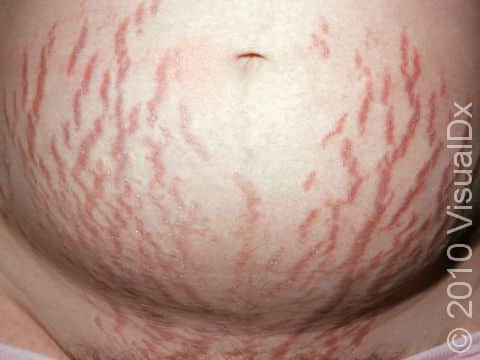Stretch Marks of Pregnancy (Striae of Pregnancy)
Striae gravidarum, stretch marks in pregnancy, occur in about 90% of all pregnant women. They are primarily due to the rapid rate at which the skin is being stretched, combined with the influence of hormones.
Who's At Risk?
Stretch marks in pregnancy usually occur in the third trimester, when the baby is growing the most. They occur more often in younger women, mothers carrying large infants, and in overweight or obese women. You have a higher risk of getting stretch marks during pregnancy if other members of your family have had them.
Signs & Symptoms
Stretch marks look like light pink to red to purple lines that mostly occur on the belly but can appear on the buttocks, breast, thighs, and upper arms.
Self-Care Guidelines
There are numerous products on the market that claim to help prevent stretch marks, but there is no accepted consensus among specialists determining what is effective. Based on a review of the medical literature, there have been two studies that compare different products to placebo (in this case, using a cream that contains no active ingredients). One study found that massage with Trofolastin cream (containing Centella asiatica extract, alpha tocopherol, and collagen-elastin hydrolysates) and verum ointment (containing tocopherol, panthenol, hyaluronic acid, elastin, and menthol) was associated with fewer women developing stretch marks. It is thought that the actual act of massage with any type of cream or ointment is beneficial to prevention of stretch marks, however.
Treatments
Most stretch marks will become smaller postpartum and fade to pale flesh- or silver-colored lines over time. There are some treatments available, but their relative risks and expected benefits should be reviewed with your physician. Topical tretinoin (Retin-A®) or oral tretinoin have been used to treat dark stretch marks. These medications should not be used without using two forms of birth control, as they have been found to cause birth defects, and should not be used by lactating women. Dermabrasion has also been used by some. The pulsed dye laser (585nm) has also been found to be helpful in lightening stretch marks, but different people will have different responses.
Visit Urgency
No therapy is necessary, as they will usually fade after delivery (postpartum).
Trusted Links
References
Bolognia, Jean L., ed. Dermatology, pp. 431, 1542-1543. New York: Mosby, 2003.
Wolff, Klaus, ed. Fitzpatrick’s Dermatology in General Medicine. 7th ed, pp. 559, 955. New York: McGraw-Hill, 2008.
Last modified on October 10th, 2022 at 4:43 pm

Not sure what to look for?
Try our new Rash and Skin Condition Finder
